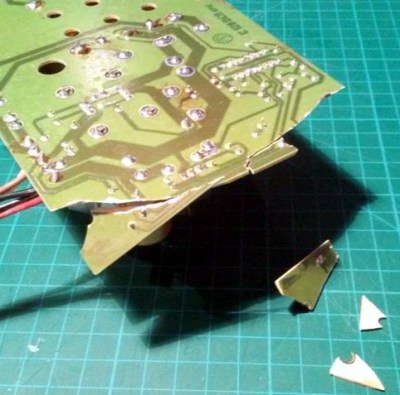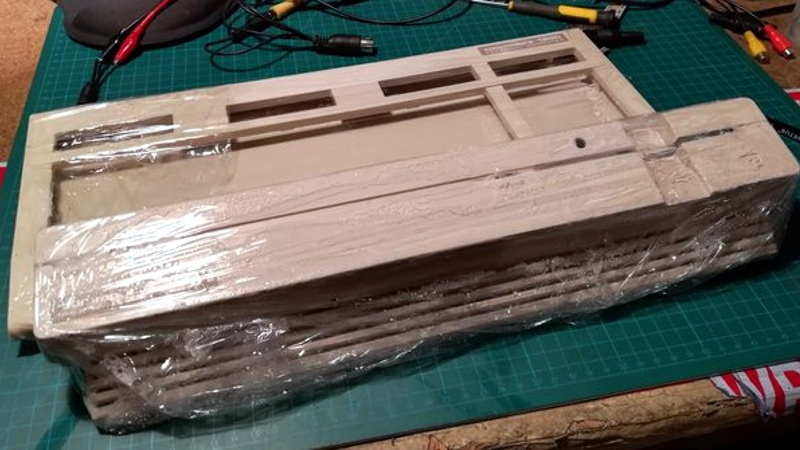Another day, another retro computer lovingly restored to like-new condition by [Drygol]. This time, the subject of his attention is a Commodore 128DCR that earned every bit of the “For Parts, Not Working” condition it was listed under. From a spider infestation to a cracked power supply PCB, this computer was in quite a state. But in the end he got the three decade old machine back in working condition and even managed to teach it a few new tricks along the way.
 Obviously the shattered PSU was the most pressing issue with the Commodore. Interestingly, the machine still had its warranty seal in place on the back, so whatever happened to this PSU seems to have occurred without human intervention.
Obviously the shattered PSU was the most pressing issue with the Commodore. Interestingly, the machine still had its warranty seal in place on the back, so whatever happened to this PSU seems to have occurred without human intervention.
Rather than just replacing the PSU, [Drygol] first pieced the board back together with the help of cyanoacrylate glue, and then coated the top with an epoxy resin to give it some mechanical strength. On the back side the traces were either repaired or replaced entirely with jumper wires where the damage was too severe.
With the PSU repaired and tested, he moved on to cleaning the computer’s main board and whitening all the plastic external components. Even the individual keycaps took a bath to get them looking like new again. This put the computer in about as close to like-new condition as it could get.
But why stop there? He next installed the JiffyDOS modification to improve system performance, and wired in an adapter that lets the computer output a crisp 80 columns over S-Video. It’s safe to say this particular Commodore is in better shape now than it was when it rolled off the assembly line.
While an impressive enough final result, this is still fairly tame for [Drygol]. If you want to see a real challenge, take a look at the insane amount of work that went into recreating this smashed Atari 800XL case.
















Minor correction: chattered PSU -> shattered PSU.
Unless, of course, it’s talking insessently about unimportant things – that would be more than annoying.
And, of course, I meant incessantly! :)
The vibrator power supplies used to step 6V/12V up to a few hundred to run a filament in a valve-based car radio used to chatter a lot too…
He should also replace the 2 large, orange capacitors on the PSU board. The capacitors are made by ROE (Roederstein) and known to sometimes mutate from capacitor to short circuit without warning when they age.
I can personally attest to that! I had one short 400v to ground in a high frequency power supply. Sounded like I was on the business end of a shotgun. Literally stunned me for a few seconds.
Very cool, to take a old BOA machine and put it back into working order after so much time.
Is that a typo for DOA, or something like b0rked on arrival ?
Bought On Auction?
Broken over all?
Banged on anvil?
Blasted outta attic?
Better off abandoned?
PSU board may have been damaged by sudden deceleration after the entire computer was dropped.
Nice to see a guy givin’ so much love to good ol’ commode door computers. :)
I doubt that spider liked the outdoors much. The house spider (either Tegenaria Domestica or the larger Eratigena Atrica) is not a fan of the cold outdoors. They can live up to 7 years indoors in rarely disturbed places, but don’t usually get past a year in the outdoors. (looked this up the first time I encountered a full grown adult in my home. I wasn’t used to spiders that big in the Netherlands. The ones outdoors don’t usually grow pas 2 centimeters leg span. This one was nearly 10 cm across. On top of the size they are one of the fastest spider species around and are SUPER fast. Another way they can surprise you)
Other than that, given the state of the PSU board I suspect the unit has been dropped at some point, the heavy transformer to break the brittle psu board. While the repair isn’t pretty you can’t argue it’s not functional :). I would personally probably have replaced the capacitors though. Those are probably on their last leg.